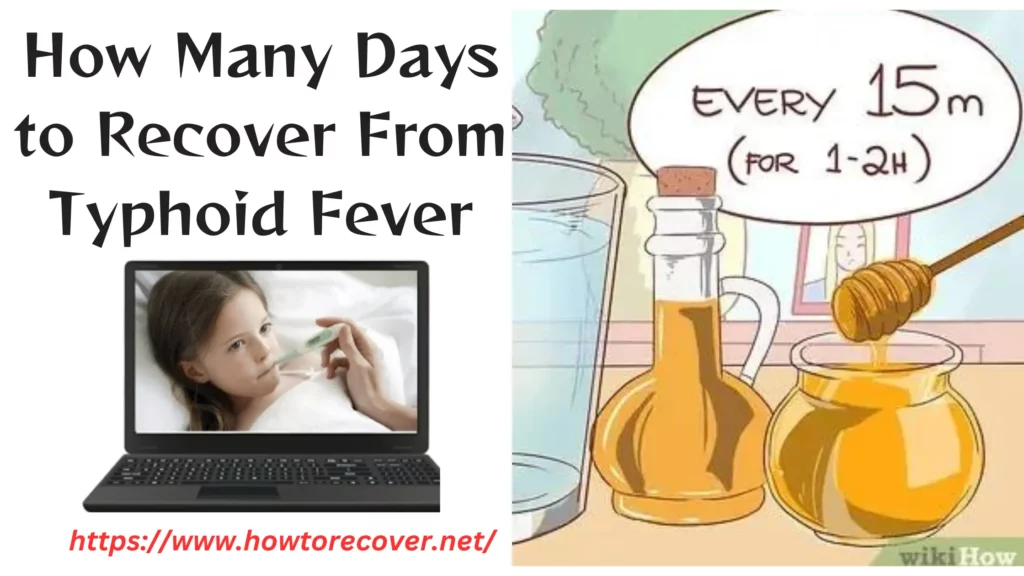How Many Days to Recover From Typhoid Fever?
Most people recover from typhoid fever with antibiotics and do not have serious complications. However, some people relapse after they have finished their antibiotic treatment. These relapses are usually milder than the first time around.
The symptoms of typhoid include having a sustained (not come and go) fever, fatigue, headache, loss of appetite, stomach pain or constipation and a rash of rose-coloured spots.
Features of Recover From Typhoid Fever
- Typhoid fever is usually spread when someone with the Salmonella typhi bacteria (which causes typhoid) eats or drinks food or water contaminated with poop or pee. The bacteria can also be spread when a person with the illness shares utensils, food or drink containers. This happens a lot in restaurants or at home with family members who are sick.
- The incubation period for typhoid fever is seven to 14 days. In most people, the illness begins with symptoms in the gastrointestinal tract such as nausea and vomiting, stomach pain and bloating, diarrhoea and sometimes constipation. Some people may get a rash on their chest or abdomen called rose spots. The disease can be serious in young children and older adults or in those with weakened immune systems, like HIV-positive people.
- Symptoms of typhoid fever can be severe and last for a few weeks. Occasionally, the infection can lead to complications such as bloody diarrhoea, abdominal pain, fever, headache, fatigue and loss of appetite. In a small number of cases, the typhoid bacteria can spread to other organs in the body leading to a life-threatening condition called peritonitis.
- A doctor can diagnose typhoid fever by looking for the bacteria in a sample of your blood, poop or urine. They will also ask about your travel history and any symptoms you have. Your doctor will give you antibiotics to treat the typhoid fever. If you are not treated, the symptoms can last for weeks and can be fatal.
How long does it take to recover from typhoid?
Most people recover within seven to 10 days of treatment, especially if they start antibiotics soon after their symptoms begin. But if the disease is not treated, it can last several weeks or longer and lead to severe complications such as stomach perforation, kidney failure, pneumonia, meningitis or brain inflammation. It can also be fatal.
The bacteria that cause typhoid fever can be spread through unclean food or water, or by person-to-person contact. Symptoms usually include a sustained high fever, headache, loss of appetite, abdominal pain and diarrhoea that can range from mild to severe. In some cases, the patient may develop a rash of flat, rose-coloured spots on their chest or back. People with active typhoid fever should stay away from work, school and children’s daycare centres until their stool has been tested for the presence of the germ. Those who do return to these activities must practice good hygiene and be careful to wash their hands often.
A vaccine is available for people who travel to areas where typhoid fever is common. It is given as an oral tablet or an injectable shot and must be administered at least two weeks before travelling to the area. Other preventive measures include drinking only bottled or boiled water and washing all foods and utensils thoroughly. It is also important to avoid eating street foods, raw vegetables and fruits that cannot be washed or peeled, and ice in drinks.
How long does it take to get better from typhoid?
Typhoid fever is a bacterial infection that is spread through food or water contaminated with Salmonella typhi bacteria. It usually starts in the intestines and then moves to other parts of the body. However, it is most common in places where sanitation is poor and sewage or dirty water flows into the food or drinking water supply. It is also more common in areas where there are fewer people to wash and sanitize the food or water.
The first sign of typhoid is a low-grade fever that gets higher over a few days. Often the stomach hurts and there is diarrhoea. In about a third of cases, there is a rash of flat, rose-coloured spots on the skin. Most people get better within a week with antibiotic treatment. But without antibiotics, typhoid is deadly in about 10% of cases.
Most people with typhoid fever who are treated in hospital recover well. They need to drink plenty of fluids to prevent dehydration. They should not go to work or school until their stools have passed, and they should avoid contact with vulnerable people such as children under 5, the elderly and ill people who are in poor health.
Some people have recurring symptoms of typhoid fever, and this is known as a relapse. They should seek medical attention as soon as possible. They may need further treatment in hospital. About 5% of people who get typhoid fever never fully recover from it and become carriers, spreading the bacteria to others.
How long does it take to get better from paratyphoid?
With proper treatment, most people recover from typhoid fever in seven to 10 days. Without treatment, the illness can last three weeks or longer and can lead to complications like a severe headache, constipation, enlarged spleen or liver, and blood-clotting problems. Death from typhoid fever occurs in less than 1% of cases.
Typhoid fever is caused by Salmonella typhi bacteria that enter the body through the mouth. The bacteria then travel through the intestines, where they multiply, and spread to other organs. The bacteria are resistant to the body’s natural defences and can survive in the bloodstream, where they attack other tissues and cells. Symptoms include fever, headache, abdominal pain, diarrhoea and a rash.
Some people with typhoid fever have a rash that appears as a group of warm pink spots on the chest, stomach and back. These spots are called rose spots and are more common in people with light skin. If you have rose spots, it’s important to drink plenty of fluids and get enough rest. If you’re dehydrated, call your doctor.
Once you feel better, it’s important to continue taking your antibiotics as prescribed. It’s also important to wash your hands frequently and to avoid eating from street food stands. If you live or work in an area where typhoid is common, talk to your employer about getting vaccinations against Salmonella typhi. You should also consider using bottled water and boiling tap water before drinking it.
How long does it take to get better from salmonella typhi?
A person who has typhoid fever recovers faster if they start antibiotic treatment immediately. If they get treated before the bacteria has a chance to spread to other organs, it is less likely to cause serious complications. During recovery, patients should drink plenty of fluids to avoid dehydration. They should also eat bland foods and avoid raw fruits and vegetables. If the infection has caused a lot of blood in the stool, they should get a coagulation screen done. Those who have had typhoid fever should not work as food handlers until they are tested negative for Salmonella typhi.
Taking antibiotics is the only way to cure typhoid fever. Doctors usually prescribe ciprofloxacin (Cipro) for nonpregnant people and chloramphenicol for pregnant women. They may ask the patient where they travelled, what they ate and drank, and how long they have been sick to help them decide which antibiotic is best for them.
If someone who has typhoid fever does not get treatment, they can become a carrier and spread the disease to others for up to a year. Some carriers need surgery to have their gallbladder removed to fully get rid of the bacteria. Getting a vaccine and following proper hygiene can help prevent typhoid fever.
Conclusion
Conclusion: Typhoid fever is a serious illness but most people make a full recovery after a course of antibiotics. The sooner you start treatment the better. It is especially important to drink lots of fluids, as dehydration can make symptoms worse. Acetaminophen can be used to help reduce fever and make you feel more comfortable.


